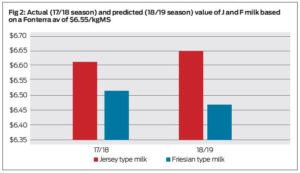Fat is back.
Roger Ellison
IN FIVE years, wool will be worth more to a sheep farmer than will a lamb.If someone said that to you today you would probably think they were mad. Today synthetic fibres from clothes are clogging the oceans with nondegradable microfibres. Wool will come back! We have already seen something akin to this happen with milk fat. In the 2009-10 season milk fat only earned one third of a dairy farmer’s milk income. Between 2010 and 2015, the five years prior to the current surge in fat value, milk fat earned 38% of the farmer’s milk income (refer figure 1). Then came the questioning the science of the 1950s and 60s which said animal fat was bad for us. Today, Fonterra is paying almost parity. Next season a kg of fat will be earning suppliers much more than a kg of protein. Fat is back; it has been 30-40 years since we last saw this.
Couple this with the fact that dairy cows produce more kg of milk fat than milk protein in a season and the growing impact of fat on the milk income becomes obvious.It is projected that next season the proportion of income from milk fat will be close to double what it was five years ago, with a corresponding halving of the protein component.
The ramifications of this resurgence in milk fat value are great. The impact as outlined above is based on a crossbred herd producing milk at the company average protein: fat ratio of 0.77, and 8.75% milk solids. Such milk will earn the company average per kg milk solids.
Every farmer will benefit from this resurgence in milk fat value, irrespective of cow breed or milk type because milk fat is such a large component of milk solids (1.2 – 1.5 times the quantity of milk protein).
However, some farmers will benefit more than others depending on how far their herd’s milk constituents vary from the company average in terms of P:F ratio and milk solids percent (Table 2, Figure 2). What this means is that this season, concentrated milk with a lower P:F ratio (more fat/kgMS) will be paying $0.10/kg MS more than dilute milk with a high P:F ratio (less fat/kgMS).
Next season, at the same payout as this season and with the projected increase in fat value relative to protein, the difference between these two types of milk will be about $0.18/kgMS.
For the average NZ herd of 414 cows, producing 380kgMS/cow, this difference equates to $28,000.
The concentrated, low P:F ratio milk is typical of that produced by predominantly Jersey herds whereas the lower milk solids and high P:F ratio milk is typical of milk produced by predominantly Holstein-Friesian herds.Indications from industry commentators are that this strong value for milk fat is likely to be long term. Fat is no longer considered bad for our health and Fonterra’s Food Service division is experiencing unprecedented demand for fat-based products like cream, cream cheese and ice cream.
• Roger Ellison is a Waikato veterinarian and dairy farmer.
“Source – Dairy News NZ, April 24, 2018”

